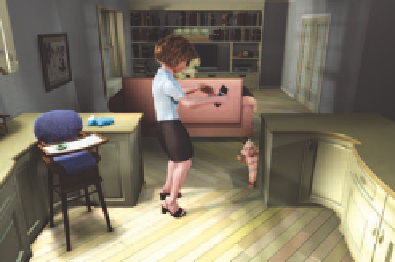Graphics Reference
In-Depth Information
This technique will work for any constraint type. It isn't limited to IK, so you have almost complete rigging
freedom on a case-by-case basis throughout your production.
Walk This Way
If you've done preliminary work in animation and followed the beginner tutorials, you've no doubt created
a walk cycle at some point. For example, characters that will be running for a long distance and not hold the
main focus of a shot will no doubt be fi ne with the traditional walk cycle methods. However, when your
main characters need to walk and move around as the central action in a shot, the walk (or run, or leap, or
shamble) should be done by hand.
Shot 7 of
The Beast
, which shows both dogs, the mother, and
the baby, has the mother turning around in place, walking to
get a better view of the living room, and kneeling to fi nd the
Beast. Figure 11.41 shows a frame of the shot.
I went through several complete attempts at animating her
turn and walk before I struck on a method that worked.
I will present you with my failures, so that you can avoid
them. The fi rst time I tried, I did the performance with
straight ahead animation. The result was like something
from a horror movie. The mother's walk, especially in the
skirt, should have been very controlled, but the straight
ahead attempt had her careering and fl inching all over the place. Instead of trying to refi ne that, I moved on
to another technique.
Figure 11.41
Shot 7 for
The Beast
For the second take, I decided to modify a method I had used to generate automatic walking in my
BlenderPeople crowd simulation script. The technique involves keyframing pelvis and foot controllers along
the motion path that I intended her to follow, but all together, much like the chess piece shuffl ing of the ani-
matic. Then I went back to the beginning of the sequence and strategically added holds along the paths the
feet were already following. As a fi nal pass, I adjusted the position of the pelvis and torso so that it was always
midway between the feet. The result of that experiment was something that, while much better than the pre-
vious attempt, lacked life. It walked like a Cylon.
I realized by obsessively watching the real-time preview of the animation that the problem was that I had been
attempting to make the feet drive the motion. When people walk, their motion is led by their center of grav-
ity, somewhere in the abdomen. The feet and legs just do their thing automatically, based on balance feedback.
So I got the bright idea to lock the legs in place and animate only the torso and deliberate arm movements
fi rst so that the motivation would come from the correct place, then go back and fi ll in the feet and legs later.
I was gratifi ed to see that Shawn Kelly of AnimationMentor.com discussed much the same technique in his
recently released free Tips and Tricks eBook download, which I recommend that you read.
To use this method, you fi rst apply a temporary
Child Of
constraint to the foot controllers so that they follow
the rest of the body around (remember to use
Set Offset
to fi x the initial
Child Of
position). You could opt

Search WWH ::

Custom Search